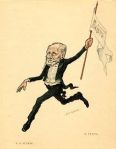Ballet fantastique in one act
Music by Felix Mendelssohn & Ludwig Minkus
World Première
26th July [O.S. 14th July] 1876
Peterhof Palace, Saint Petersburg
Original 1876 Cast
Titania
Eugenia Sokolova
Oberon
Marie Petipa
Plot
Inspired by the comic play by William Shakespeare of love, confusion and magic set in the fairy world of the Fairy King and Queen Oberon and Titania. The ballet was a large divertissement of dances by butterflies, flowers, grasshoppers and other denizens of the world of fairies and elves.

History
In 1866, Petipa had created his first ballet adaptation (and probably the first ballet adaptation in general) of William Shakespeare’s play A Midsummer Night’s Dream, with the usage of Felix Mendelssohn’s Incidental Music, arranged by Cesare Pugni. This first creation was the one-act choreographic miniature Titania. Ten years later, Petipa turned to Mendelssohn’s Incidental Music again to mount another adaptation of Shakespeare’s fairy play, under its original title A Midsummer Night’s Dream. For his second adaptation, Petipa teamed up with Ludwig Minkus, who arranged Mendelssohn’s music and added some new music numbers and the ballet was created for the 1876 summer season at Peterhof Palace. Like in Titania, Petipa’s main focus for the libretto was once again the fairyland of Oberon and Titania, but exactly how his two adaptations differed from one another and details of the respective musical arrangements and additions by Pugni and Minkus are unknown.
Petipa’s A Midsummer Night’s Dream was premièred on the 26th July [O.S. 14th July] 1876 at Peterhof Palace. An interesting fact about Petipa’s second staging is that the role of Oberon was created as a travesty role, with his daughter Marie originating the role of the Fairy King, but by the mid to late 1890s, Oberon had become a role for the men. A Midsummer Night’s Dream made its première at the Imperial Bolshoi Kamenny Theatre on the 7th October [O.S. 25th September] 1876. It was revived for another performance on the 6th November [O.S. 25th October] 1889 at the Imperial Theatre. This was also the occasion in which The Whims of the Butterfly was given its first public performance and was part of a three-part bill, which also included Lev Ivanov’s The Enchanted Forest.

Throughout the 20th century, Mendelssohn’s score has been utilised by various choreographers to create new ballet versions of A Midsummer Night’s Dream. Such productions include John Neumeier’s 1977 production for the Hamburg Ballet and Sir Frederick Ashton’s 1964 one-act staging under the title The Dream for the Royal Ballet. Perhaps the most famous full-length ballet production of A Midsummer Night’s Dream that is danced today is George Balanchine’s 1962 production for New York City Ballet. Balanchine had always been a fan of Shakespeare’s play; he had appeared as an elf in a production staged at the Mikahilovsky Theatre and had danced as an insect in Petipa’s production when he was a student, which inspired him to create his own version. This was to be Balanchine’s first full-length ballet and he spoke of his history in a discussion with Francis Mason:
Shakespeare’s ‘A Midsummer Night’s Dream’ has always been a favourite of mine ever since I first saw it and appeared in the play as a child in Russia. I was an elf in a production at the Mikhailovsky Theatre in St. Petersburg when I was about eight years old. I suppose it was then that I came to know so many lines from the play; even now I can recite in Russian speeches like the famous one of Oberon’s beginning:
‘I know a bank where the wild thyme blows,
Where oxlips and the nodding violet grows…’I worked on a production of the play at the Shakespeare Memorial Theatre in Stratford, Connecticut, in 1950, arranging some dances. But what has really interested me more than Shakespeare’s words in recent years has been the music that Mendelssohn wrote to the play, and I think it can be said that the ballet was inspired by the score.
Mendelssohn did not, however, write music for the whole play. To fill out the danced action that developed as the ballet was being made, I selected other scores of Mendelssohn’s that neatly fitted into the pattern we were making. – 101 Stories of the Great Ballets (p. 253)

A trained musician, Balanchine arranged the music score, himself, using additional music pieces by Mendelssohn from some of his other compositions including his Symphony No. 9 for Strings and The First Walpurgis Night. He also used a German tradition for the staging of A Midsummer Night’s Dream, in which Titania is portrayed by a performer who is taller than the performer portraying Oberon. Balanchine’s A Midsummer Night’s Dream was premièred on the 17th January 1962 with Melissa Hayden as Titania, Edward Villella as Oberon, Arthur Mitchell as Puck and Gloria Govin as Hippolyta.

Sources
- The George Balanchine Trust
- Balanchine, George and Mason, Francis (1979) 101 Stories of the Great Ballets. New York: Anchor Books
- Meisner, Nadine (2019) Marius Petipa, The Emperor’s Ballet Master. New York City, US: Oxford University Press
- Letellier, Robert Ignatius (2008) The Ballets of Ludwig Minkus. Cambridge Scholars Publishing
Photos and images: © Dansmuseet, Stockholm © Большой театр России © Victoria and Albert Museum, London © Государственный академический Мариинский театр © CNCS/Pascal François © Bibliothèque nationale de France © Musée l’Opéra © Colette Masson/Roger-Viollet © АРБ имени А. Я. Вагановой © Михаил Логвинов © Михайловский театр, фотограф Стас Левшин. Партнёры проекта: СПбГБУК «Санкт-Петербургская государственная Театральная библиотека». ФГБОУВО «Академия русского балета имени А. Я. Вагановой» СПбГБУК «Михайловский театр». Михаил Логвинов, фотограф. Martine Kahane.
